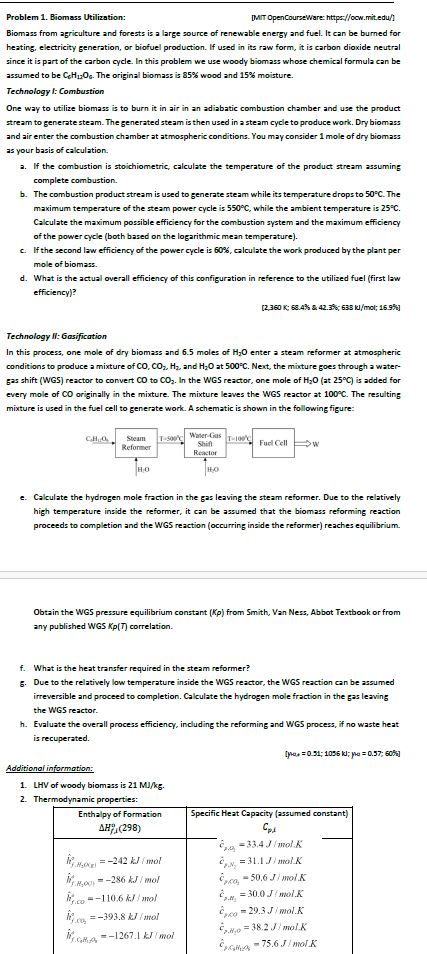Answered step by step
Verified Expert Solution
Question
1 Approved Answer
Problem 1 . Biomass Utilization: Biomass from agriculture and forests is a large source of renewable energy and fuel. It can be burned for heating,
Problem Biomass Utilization:
Biomass from agriculture and forests is a large source of renewable energy and fuel. It can be burned for
heating, electricity generation, or biofuel production. If used in its raw form, it is carbon dioxide neutral
since it is part of the carbon cycle. In this problem we use woody biomass whose chemical formula can be
assumed to be The original biomass is wood and moisture.
Technology I: Combustion
One way to utilize biomass is to burn it in air in an adiabatic combustion chamber and use the product
stream to generate steam. The generated steam is then used in a steam cycle to produce work. Dry biomass
and air enter the combustion chamber at atmospheric conditions. You may consider mole of dry biomass
as your basis of calculation.
a If the combustion is stoichiometric, calculate the temperature of the product stream assuming
complete combustion.
b The combustion product stream is used to generate steam while its temperature drops to The
maximum temperature of the steam power cycle is while the ambient temperature is
Calculate the maximum possible efficiency for the combustion system and the maximum efficiency
of the power cycle both based on the logarithmic mean temperature
c If the second law efficiency of the power cycle is calculate the work produced by the plant per
mole of biomass.
d What is the actual overall efficiency of this configuration in reference to the utilized fuel first law
efficiency
;&:;;
Technology II: Gasification
In this process, one mole of dry biomass and moles of enter a steam reformer at atmospheric
conditions to produce a mixture of and at Next, the mixture goes through a water
gas shift WGS reactor to convert to In the WGS reactor, one mole of at is added for
every mole of originally in the mixture. The mixture leaves the WGS reactor at The resulting
mixture is used in the fuel cell to generate work. A schematic is shown in the following figure:
e Calculate the hydrogen mole fraction in the gas leaving the steam reformer. Due to the relatively
high temperature inside the reformer, it can be assumed that the biomass reforming reaction
proceeds to completion and the WGS reaction occurring inside the reformer reaches equilibrium.
Obtain the WGS pressure equilibrium constant Kp from Smith, Van Ness, Abbot Textbook or from
any published WGS correlation.
f What is the heat transfer required in the steam reformer?
Due to the relatively low temperature inside the WGS reactor, the WGS reaction can be assumed
irreversible and proceed to completion. Calculate the hydrogen mole fraction in the gas leaving
the WGS reactor.
h Evaluate the overall process efficiency, including the reforming and WGS process, if no waste heat
is recuperated.
Additional information:
LHV of woody biomass is
Thermodynamic properties:

Step by Step Solution
There are 3 Steps involved in it
Step: 1

Get Instant Access to Expert-Tailored Solutions
See step-by-step solutions with expert insights and AI powered tools for academic success
Step: 2

Step: 3

Ace Your Homework with AI
Get the answers you need in no time with our AI-driven, step-by-step assistance
Get Started


